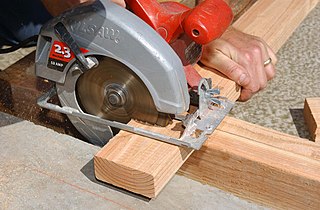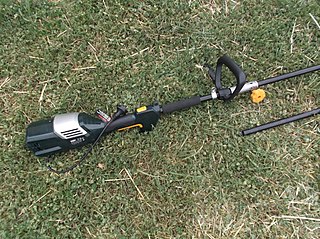
The router is a power tool with a flat base and a rotating blade extending past the base. The spindle may be driven by an electric motor or by a pneumatic motor. It routs an area in hard material, such as wood or plastic. Routers are used most often in woodworking, especially cabinetry. They may be handheld or affixed to router tables. Some woodworkers consider the router one of the most versatile power tools.

A circular saw or a buzz saw, is a power-saw using a toothed or abrasive disc or blade to cut different materials using a rotary motion spinning around an arbor. A hole saw and ring saw also use a rotary motion but are different from a circular saw. Circular saws may also be loosely used for the blade itself. Circular saws were invented in the late 18th century and were in common use in sawmills in the United States by the middle of the 19th century.
A power tool is a tool that is actuated by an additional power source and mechanism other than the solely manual labor used with hand tools. The most common types of power tools use electric motors. Internal combustion engines and compressed air are also commonly used. Tools directly driven by animal power are not generally considered power tools.

Hydraulic rescue tools, also known as jaws of life, are used by emergency rescue personnel to assist in the extrication of victims involved in vehicle accidents, as well as other rescues in small spaces. These tools include cutters, spreaders, and rams. Such devices were first used in 1963 as a tool to free race car drivers from their vehicles after crash.

A lawn mower is a device utilizing one or more revolving blades to cut a grass surface to an even height. The height of the cut grass may be fixed by the design of the mower but generally is adjustable by the operator, typically by a single master lever or by a mechanism on each of the machine's wheels. The blades may be powered by manual force, with wheels mechanically connected to the cutting blades so that the blades spin when the mower is pushed forward, or the machine may have a battery-powered or plug-in electric motor. The most common self-contained power source for lawn mowers is a small internal combustion engine. Smaller mowers often lack any form of self-propulsion, requiring human power to move over a surface; "walk-behind" mowers are self-propelled, requiring a human only to walk behind and guide them. Larger lawn mowers are usually either self-propelled "walk-behind" types or, more often, are "ride-on" mowers that the operator can sit on and control. A robotic lawn mower is designed to operate either entirely on its own or less commonly by an operator on a remote control.

A leaf blower, commonly known as a blower, is a device that propels air out of a nozzle to move debris such as leaves and grass cuttings. Leaf blowers are powered by electric or gasoline motors. Gasoline models have traditionally been two-stroke engines, but four-stroke engines were recently introduced to partially address air pollution concerns. Leaf blowers are typically self-contained handheld units, or backpack mounted units with a handheld wand. The latter is more ergonomic for prolonged use. Larger units may rest on wheels and even use a motor for propulsion. These are sometimes called "walk-behind leaf blowers" because they must be pushed by hand to be operated. Some units called blower vacs, can also suck in leaves and small twigs via a vacuum, and shred them into a bag.

A mower is a person or machine that cuts (mows) grass or other plants that grow on the ground. Usually mowing is distinguished from reaping, which uses similar implements, but is the traditional term for harvesting grain crops, e.g. with reapers and combines.

An electric shaver is a razor with an electrically powered rotating or oscillating blade. The electric shaver usually does not require the use of shaving cream, soap, or water. The razor may be powered by a small DC motor, which is either powered by batteries or mains electricity. Many modern ones are powered using rechargeable batteries. Alternatively, an electro-mechanical oscillator driven by an AC-energized solenoid may be used. Some very early mechanical shavers had no electric motor and had to be powered by hand, for example by pulling a cord to drive a flywheel.

A wood shaper, is a stationary woodworking machine in which a vertically oriented spindle drives one or more stacked cutter heads to mill profiles on wood stock.
An edge trimmer or lawn edger is a garden tool, either manual or motorised, to form distinct boundaries between a lawn, typically consisting of a grass, or other soft botanical ground cover, and another ground surface feature such as a paved, concreted or asphalted area, or a granular material such as sand or gravel, or simply uncovered soil, for example an unbounded garden.

A hedge trimmer, shrub trimmer, or bush trimmer is a gardening tool or machine used for trimming hedges or solitary shrubs (bushes). Different designs as well as manual and powered versions of hedge trimmers exist. Hedge trimmers vary between small hand-held devices to larger trimmers mounted on tractors.

Makita Corporation is a Japanese manufacturer of power tools. Founded on March 21, 1915, it is based in Anjō, Japan and operates factories in Brazil, China, Japan, Mexico, Romania, the United Kingdom, Germany, United Arab Emirates, Thailand, Canada, and the United States. Annual sales were equivalent to $3.1 billion in 2012.
The Husqvarna Group is a Swedish manufacturer of outdoor power products including robotic lawn mowers, chainsaws, trimmers, brushcutters, cultivators, and garden tractors. Founded as a firearms manufacturer in 1689, it is one of the oldest continuously running companies in the world. Headquartered in Stockholm, Sweden, the group also produces consumer watering products under the brand Gardena, cutting equipment and diamond tools for the construction and stone industries.

A rotary mower is a unit of powered machinery that uses a rotating blade or blades to cut vegetation.

Homelite Corporation is an American power equipment manufacturer, i.e., that became notable for being one of the largest post-World War II manufacturers of portable electrical generators and professional and consumer level chainsaws, as well as holding the distinction of producing the world's first one-man operated chainsaw.
A weedeater is a powered handheld device that uses a flexible monofilament line instead of a blade for cutting grass and other plants near objects.
George Charles Ballas Sr. was an American entrepreneur. He invented the first string trimmer, known as the Weed Eater in 1971. He was the father of ballroom dancer, Corky Ballas, and grandfather of professional dancer Mark Ballas of Dancing with the Stars.

Oregon Tool, Inc. is an American company that manufactures saw chain and other equipment for the forestry, agriculture, and construction industries. Based in Portland, Oregon, Oregon Tool globally manufactures their products in ten different plants across five countries. Oregon Tool produces and markets saw chain, chain saw bars and sprockets, battery operated lawn and garden equipment, lawn mower blades, string trimmer line, concrete cutting saws and chain, and agricultural cutting equipment for OEMs, dealers, and end-user markets. Oregon Tool employs approximately 3,300 people across the world in 17 global locations.
Emak is an Italian manufacturer and distributor of machines, components and accessories for gardening, agriculture, forestry and industrial applications. Emak's brands are: Efco, Oleo-Mac, Bertolini and Nibbi.

A brushcutter is a powered garden or agricultural tool used to trim weeds, small trees, and other foliage not accessible by a lawn mower or rotary mower. Various blades or trimmer heads can be attached to the machine for specific applications.

















